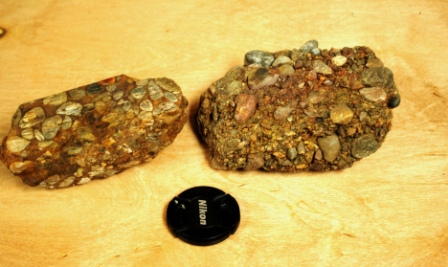
|
By Margi Jenks In addition to the diamonds that are found here at the Crater of Diamonds State Park, we find a number of other interesting or beautiful rocks and minerals. Favorite rocks for our visitors to collect are amethyst, calcite, barite and quartz crystals, lamproite lava and ash, and rounded pieces of jasper. My favorite, however, is often overlooked because it looks like a chunk of concrete, and in a sense that is true, but it is nature’s concrete. The rock that I am talking about is puddingstone. The scientific name for puddingstone is an iron-cemented conglomerate, but it got its common name because it looks like the Christmas fruitcakes/puddings that people ate in England in the 1800’s, which is where the name “puddingstone” was first associated with this rock. I have even been known to call it “rocky road stone” after the rocky road ice cream we enjoy these days. So, when you come to the Crater to look for diamonds, you probably will find lots of pieces of puddingstone, and you are also allowed to take them home with you as souvenirs. To find a chunk of puddingstone, look for a rock that is bristling with lots of pebble to cobble sized rounded stones.
 The stones are called jasper and they originally came from the much younger and higher peaks of the Ouachita Mts. They were rounded by the tumbling action of flowing water, as they were carried down in the streams and rivers that drained the Ouachita Mts. Many places in the area of the Crater contain up to 20’ of the jasper stream gravels. The rounded jasper gravel as well as sand were deposited during the spring flood time in stream areas that during the summer and fall months became swamps. As the summer temperatures evaporated the standing water in the swamps, the remaining water that saturated the gravels and sands in the bottom of the swamps contained higher and higher concentrations of dissolved iron. At some point the bottom parts of the remaining water no longer contained oxygen and also became very acidic. With these three conditions, iron crystals began to form in the tiny spaces between the bottom sand and gravel pieces, eventually completely filling the holes between the pebbles. Puddingstone is not just found in the area of the Crater. Many people in the Murfreesboro and Nashville areas will recognize it from the stones they find in the front yards. I have even noticed that the outsides of a couple of houses and out buildings in the area are covered with puddingstone chunks.
When puddingstone is cut with a diamond saw, the insides of the pebbles are revealed. Then, it can either be further polished or you can spray it with clear lacquer to show all the colors of the iron cement and the insides of the pebbles. This year I warned my family to expect a “rocky” Christmas from me, and I suspect they are hoping that I mean diamonds. However, instead, I am giving them beautiful puddingstone paper weights, and I hope that they will find them to be just as lovely and interesting as I do. And so, I hope for you and yours a “rocky” Merry Christmas. Search area last plowed: October 21, 2009, Total diamonds so far in 2009 - 887 Diamond finds for December 7th to December 13th (100 pts. = 1 carat): December 7 - David Anderson, Kent City, MI, 14 pt. white, 19 pt. yellow; Thomas Houser, Bossier City, LA, 2 pt. white, 26 pt. white December 10 - Glenn Worthington, Springdale, AR, 2 pt. white December 11 - Bud Chadwick, Cudjoe Key, FL, 8 pt. white, 37 pt. white December 13 - Melissa and Kenny Oliver, Rosston, AR, 16 pt. white |

209 State Park Road
Murfreesboro, AR 71958
Email: craterofdiamonds@arkansas.com
Phone: (870) 285-3113
You are currently subscribed to the Crater of Diamonds State Park enewsletter as: &*TO;.
To unsubscribe, go to http://diamondsstatepark.xyz/newsletter/ and click the "Unsubscribe" button.
